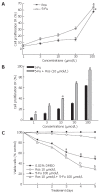Rosiglitazone enhances fluorouracil-induced apoptosis of HT-29 cells by activating peroxisome proliferator-activated receptor gamma
- PMID: 17461445
- PMCID: PMC4146895
- DOI: 10.3748/wjg.v13.i10.1534
Rosiglitazone enhances fluorouracil-induced apoptosis of HT-29 cells by activating peroxisome proliferator-activated receptor gamma
Abstract
Aim: To examine whether and how rosiglitazone enhances apoptosis induced by fluorouracil in human colon cancer (HT-29) cells.
Methods: Human colon cancer HT-29 cells were cultured in vitro and treated with fluorouracil and/or rosiglitazone. Proliferation and growth of HT-29 cells were evaluated by MTT assay and trypan blue exclusion methods, respectively. The apoptosis of HT-29 cells was determined by acridine orange/ethidium bromide staining and flow cytometry using PI fluorescence staining. The expressions of peroxisome proliferator-activated receptor gamma (PPARgamma), Bcl-2 and Bax in HT-29 cells were analyzed by Western blot.
Results: Although rosiglitazone at the concentration below 30 micromol/L for 72 h exerted almost no inhibitory effect on proliferation and growth of HT-29 cells, it could significantly enhance fluorouracil-induced HT-29 cell proliferation and growth inhibition. Furthermore, 10 micromol/L rosilitazone did not induce apoptosis of HT-29 cells but dramatically enhanced fluorouracil-induced apoptosis of HT-29 cells. However, rosiglitazone did not improve apoptosis induced by fluorouracil in HT-29 cells pretreated with GW9662, a PPARgamma antagonist. Meanwhile, the expression of Bax and PPARgamma was up-regulated, while the expression of Bcl-2 was down regulated in HT-29 cells treated with rosiglitazone in a time-dependent manner. However, the effect of rosiglitazone on Bcl-2 and Bax was blocked or diminished in the presence of GW9662.
Conclusion: Rosiglitazone enhances fluorouracil-induced apoptosis of HT-29 cells by activating PPARgamma.
Figures



References
-
- Austin RP, Barton P, Cockroft SL, Wenlock MC, Riley RJ. The influence of nonspecific microsomal binding on apparent intrinsic clearance, and its prediction from physicochemical properties. Drug Metab Dispos. 2002;30:1497–1503. - PubMed
-
- Shin YK, Yoo BC, Chang HJ, Jeon E, Hong SH, Jung MS, Lim SJ, Park JG. Down-regulation of mitochondrial F1F0-ATP synthase in human colon cancer cells with induced 5-fluorouracil resistance. Cancer Res. 2005;65:3162–3170. - PubMed
-
- Akbulut H, Tang Y, Maynard J, Zhang L, Pizzorno G, Deisseroth A. Vector targeting makes 5-fluorouracil chemotherapy less toxic and more effective in animal models of epithelial neoplasms. Clin Cancer Res. 2004;10:7738–7746. - PubMed
-
- Meta-analysis of randomized trials testing the biochemical modulation of fluorouracil by methotrexate in metastatic colorectal cancer. Advanced Colorectal Cancer Meta-Analysis Project. J Clin Oncol. 1994;12:960–969. - PubMed
-
- Thirion P, Michiels S, Pignon JP, Buyse M, Braud AC, Carlson RW, O'Connell M, Sargent P, Piedbois P. Modulation of fluorouracil by leucovorin in patients with advanced colorectal cancer: an updated meta-analysis. J Clin Oncol. 2004;22:3766–3775. - PubMed
Publication types
MeSH terms
Substances
LinkOut - more resources
Full Text Sources
Medical
Research Materials
Miscellaneous

